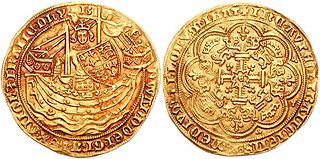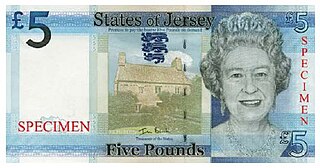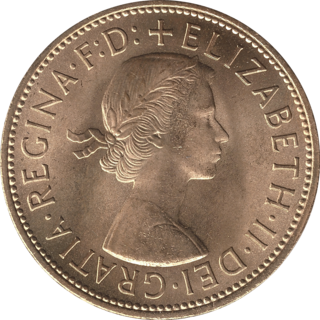
The standard circulating coinage of the United Kingdom, British Crown Dependencies and British Overseas Territories is denominated in pennies and pounds sterling, and ranges in value from one penny sterling to two pounds. Since decimalisation, on 15 February 1971, the pound has been divided into 100 (new) pence. Before decimalisation, twelve pence made a shilling, and twenty shillings made a pound. British coins are minted by the Royal Mint in Llantrisant, Wales. The Royal Mint also commissions the coins' designs.

The noble was the first English gold coin produced in quantity, introduced during the second coinage (1344–1346) of King Edward III. It was preceded by the gold penny and the florin, minted during the reign of King Henry III and the beginning of the reign of King Edward III; these saw little circulation. The derivatives of the noble, the half noble and quarter noble, on the other hand, were produced in quantity and were very popular.

This is the history of the English penny from the years 1154 to 1485.

The History of the English penny from 1485 to 1603 covers the period of the Tudor dynasty.

The history of the English penny from 1603 to 1707 covers the period of the House of Stuart, up to the Acts of Union of 1707 which brought about the Union of the Kingdom of England with the Kingdom of Scotland.

The penny of Great Britain and the United Kingdom from 1714 to 1901, the period in which the House of Hanover reigned, saw the transformation of the penny from a little-used small silver coin to the bronze piece recognisable to modern-day Britons. All bear the portrait of the monarch on the obverse; copper and bronze pennies have a depiction of Britannia, the female personification of Britain, on the reverse.

The double florin, or four-shilling piece, was a British coin produced by the Royal Mint between 1887 and 1890. One of the shortest-lived of all British coin denominations, it was struck in only four years. Its obverse, designed by Joseph Boehm and engraved by Leonard Charles Wyon, depicts Queen Victoria, whilst the reverse, featuring national symbols of the United Kingdom, was designed by Wyon based on the coinage of Charles II.

The British florin, or two-shilling coin, was issued from 1849 until 1967, with a final issue for collectors dated 1970. Equivalent in value to one-tenth of a pound, it was the last coin circulating immediately prior to decimalisation to be demonetised, in 1993, having for a quarter of a century circulated alongside the ten-pence piece, identical in specifications and value.
The pound is the currency of Guernsey. Since 1921, Guernsey has been in currency union with the United Kingdom and the Guernsey pound is not a separate currency but is a local issue of banknotes and coins denominated in pound sterling, in a similar way to the banknotes issued in Scotland, England and Northern Ireland. It can be exchanged at par with other sterling coinage and notes.

The pound is the currency of Jersey. Jersey is in currency union with the United Kingdom, and the Jersey pound is not a separate currency but is an issue of banknotes and coins by the States of Jersey denominated in pound sterling, in a similar way to the banknotes issued in Scotland and Northern Ireland. It can be exchanged at par with other sterling coinage and notes.
The Manx pound is the currency of the Isle of Man, in parity with the pound sterling. The Manx pound is divided into 100 pence. Notes and coins, denominated in pounds and pence, are issued by the Isle of Man Government.

The coins of Lundy are unofficial issues of currency from the island of Lundy, in the Bristol Channel off the west coast of England. Two bronze coins, the "half puffin" and "one puffin", were issued with a 1929 date and featured a portrait of Martin Coles Harman who owned the island and was responsible for the issue. The coins were struck again with slightly modified designs and updated dates in 1965, 1977, and 2011, as commemorative tokens not intended for circulation.
Newfoundland, as a separate British colony, produced its own decimal currency between 1865 and 1947. The coins of Newfoundland are of historical importance as Newfoundland was a British colony until 1907, and a Dominion until 1949, when Newfoundland and Labrador became the tenth province of Canada.
The coins of the South African pound were part of the physical form of South Africa's historical currency, the South African pound. Prior to the Union of 1910, various authorities issued their own pounds, some as independent entities. After the Union but before 1923, coins in circulation were mostly British, but the coins of Paul Kruger's South African Republic remained in circulation. In 1923, South Africa began to issue its own coins, adopting coins that were identical in size and value to those used in Great Britain: 12 pence (12d) = 1 shilling (1s), and 20s = 1 pound (£1). On 14 February 1961, the Union of South Africa adopted a decimal currency, replacing the pound with the Rand.
Christopher Ironside OBE, FRBS was an English painter and coin designer, particularly known for the reverse sides of the new British coins issued on decimalisation in 1971.

Conder tokens, also known as 18th-century provincial tokens, were a form of privately minted token coinage struck and used during the latter part of the 18th century and the early part of the 19th century in England, Anglesey and Wales, Scotland, and Ireland.

The Australian pre-decimal halfpenny coin, commonly known as a ha’penny, was the smallest denomination of the Australian Pound in circulation. It was a unit of currency that equalled half of a penny, 1/24 of a shilling or 1/480 of a pound. The coin was made to be equivalent to the British halfpenny; its dimensions, composition and values were equivalent, and additionally, the two currencies were fixed at par.
A coin was issued for circulation in Connaught during the reign of King Edward VI of England (1547–53). It is a contemporary forgery of the extremely rare English shilling of that reign. It was struck in brass, and, occasionally, in copper. This interesting coin was known by the nickname 'Bungal', whose origin is not yet known. It circulated as a 1 penny coin.

The pre-decimal penny (1d) was a coin worth 1⁄240 of a pound sterling, or 1⁄12 of a shilling. Its symbol was d, from the Roman denarius. It was a continuation of the earlier English penny, and in Scotland it had the same monetary value as one pre-1707 Scottish shilling. The penny was originally minted in silver, but from the late 18th century it was minted in copper, and then after 1860 in bronze.

The pre-decimal twopence (2d) was a coin worth 1/120 of a pound sterling, or two pence. It was a short-lived denomination in copper, being minted in only 1797 by Matthew Boulton's Soho Mint.











